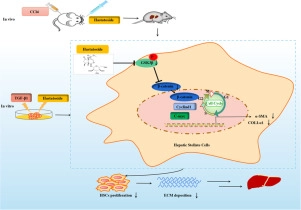Hastatoside attenuates carbon tetrachloride-induced liver fibrosis by targeting glycogen synthase kinase-3β

Background
Hastatoside is an iridoid glycoside extracted from the herb, Verbena officinalis, that exerts various pharmacological effects, including anti-inflammatory, sleep-promoting, and analgesic effects. However, only a few studies have reported the efficacy of hastatoside in liver fibrosis. Liver fibrosis is a pathophysiological process, and its persistence can seriously affect the quality of life and well-being of the patients.
Hypothesis/Purpose
This study aimed to investigate the role of hastatoside on liver fibrosis and its possible underlying mechanisms.
Methods
C57BL/6J mice with carbon tetrachloride (CCl4)-induced hepatic fibrosis were used as the in vivo models. Histological features of the liver were observed using Masson's trichrome and hematoxylin–eosin staining. Alanine aminotransferase and aspartate aminotransferase levels and the hepatic fibrosis indices (type 3 procollagen, laminin, and hyaluronic acid) were measured using corresponding assay kits. LX-2 human hepatic stellate cells (HSCs) stimulated with the transforming growth factor β1 were used as the vitro models. Transfection of the glycogen synthase kinase (GSK)-3β small interfering RNA (siRNA) and β-catenin plasmids was also performed in vitro. Protein levels of GSK-3β, phospho-GSK-3β (Ser 9), α-smooth muscle actin, collagen type I alpha 1, c-Myc, cyclin D1, and β-catenin were determined via western blotting. Moreover, the p-GSK-3β:GSK-3β ratio was calculated to determine the GSK-3β activity.
Results
Hastatoside prevented CCl4-induced liver injury and histological damage. It inhibited the upregulation of α-SMA and Col1α1 levels in a CCl4-induced mouse hepatic fibrosis model. In vitro, hastatoside inhibited the proliferation and activation of HSCs by decreasing the expression levels of cyclin D1 and c-Myc and the proportion of LX-2 cells activated in the G0/G1 phase. Molecular docking results showed that hastatoside bound to GSK-3β. Hastatoside significantly increased the GSK-3β activity and inhibited the downstream effector expression of β-catenin.
Conclusion
These findings suggest that hastatoside can bind to GSK-3β and promote its activity, while inhibiting the GSK-3β downstream effector expression of β-catenin, thereby inhibiting the activation and proliferation of HSCs, which further prevents the development of liver fibrosis. These results provide innovative insights into the underlying liver fibrosis. Moreover, hastatoside is a potential anti-fibrosis monomer that can potentially be used for the treatment of liver fibrosis.
Publisher URL: https://www.sciencedirect.com/science/article/pii/S0944711322006730
DOI: 10.1016/j.phymed.2022.154585
Keeping up-to-date with research can feel impossible, with papers being published faster than you'll ever be able to read them. That's where Researcher comes in: we're simplifying discovery and making important discussions happen. With over 19,000 sources, including peer-reviewed journals, preprints, blogs, universities, podcasts and Live events across 10 research areas, you'll never miss what's important to you. It's like social media, but better. Oh, and we should mention - it's free.
Researcher displays publicly available abstracts and doesn’t host any full article content. If the content is open access, we will direct clicks from the abstracts to the publisher website and display the PDF copy on our platform. Clicks to view the full text will be directed to the publisher website, where only users with subscriptions or access through their institution are able to view the full article.


